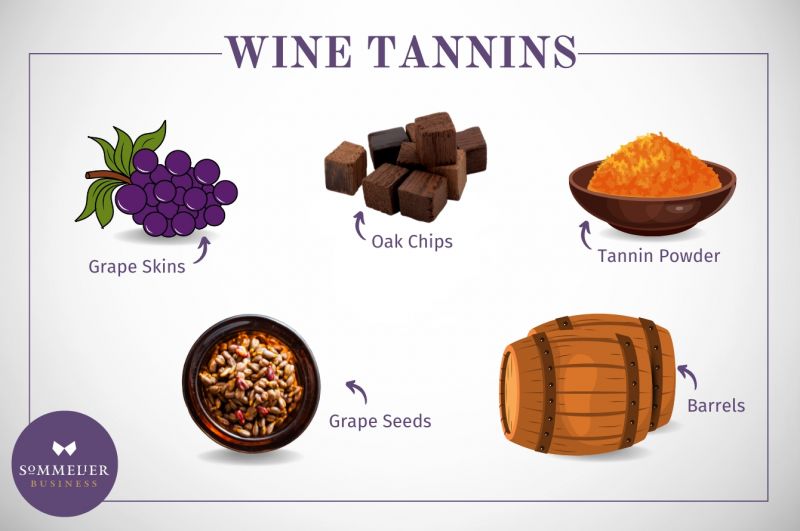Educating Sommeliers Worldwide.
By Beverage Trade Network

Tannin (or tannic acid) is a water-soluble polyphenol present in many plant foods, including grape skins, seeds, and stems. They are astringent, as in very strong tea, and can be bitter. In solution, like in wine or saliva, tannins bind to and may precipitate proteins and other organic compounds including amino acids and alkaloids.
Wine expert Gus Clemens describes the dark side of tannins:
“They are horrid because that is what nature wants tannins to be. Tannins are the astringent, unpleasant taste in unripe fruit that deters animals from eating a plant’s fruit and seeds before they are ripe. Tannins from tree bark are used to tan animal hides. Neither appetizing.”
In wine, however, tannins have very positive aspects. They can be delicious and contribute to a wine’s capacity to mature and improve over time. They exist not just in wine, but also tea, coffee, and chocolate.
So, can tannins help sell wine in restaurants and wine bars? Yes. A sommelier’s knowledge of tannins in each wine on the list combined with information received from clients can make for winning recommendations and successful upselling.
First, a review of tannin chemistry is in order.
White wine is generally low in tannins while red wines and orange wines have plenty because of extended contact of the must with the grape skins and seeds (and sometimes stems) during winemaking. Tannins change as grapes mature and also as wine is made and then ages. Astringency in grapes peaks at veraison, which is when ripening begins. Proanthocyanidins are the natural tannins in grapes. These flavonoids are oligomers or polymers of catechins, which are relatively small and responsible for bitterness in wine, while larger tannins produce the sensation of astringency, or drying, in the mouth.
Polymeric pigments are formed by tannins during winemaking. These are responsible for the stable red color found in aged wines. Extended maceration, even up to 40 or 60 days but usually less, during winemaking will help extract more tannins into red wine. Another technique to increase tannins (and phenolic and aroma compounds) is the Saignée technique.
A wine’s tannin makeup is critically important to its taste, color, mouthfeel, and aging potential; it also provides clues about a wine’s origins in terms of terroir and the grape variety or varieties used in making the wine.
It’s the tannins in red wine that cause many novice wine drinkers to opt for white wines or sweeter wines. Tannins in wine are sensed in the mouth in different ways and places (gums, lips, tongue, etc.). Tannins soften with age. They can be described as velvety, bold, soft, fine-grained, green, ripe, coarse, abundant, silky, sandy, polymerized, etc. Tannins are complex and not totally understood. Research is underway.
[[relatedPurchasesItems-41]]
Tannins may also come from the wooden barrels used in wine aging, usually oak. These are technically known as enological tannins. New barrels will impart more tannins to wine than used barrels. Seasoned barrels may impart very few tannins. Oak tannins are felt as slightly grainy and “hard.” They lack the suppleness of grape tannins, but they too will soften with aging.
Grape varieties known to have high levels of tannins include Cabernet Sauvignon, Tannat (hence the name), Nebbiolo, and possibly Syrah/Shiraz. Those with moderate tannin levels include Merlot, Sangiovese, Grenache, and Cabernet Franc. Tannins in wine are not tasted per se; they are sensed. It is not only the quantity that is important to the mouthfeel but also the type or quality of tannins, which affects “their tendency to ‘stick’ to another surface such as the mucous membranes,” says the Oxford Companion to Wine.
Wines with lots of extracted tannins are generally designed by the winemaker for longer cellaring and are more expensive.
Tannins are important to a wine’s mouthfeel, enjoyment, and aging potential. When tasting a red wine, it’s important to consider the types and levels of tannins as well as, believe it or not, where they are felt in the mouth, and their location. Tannins are most acutely appreciated at the finish of red wine.
The more and the more rapidly the tannins in red wine dry out your mouth, the higher the tannin level in wine. Master of Wine Nick Jackson has proposed a technique to help wine tasters, including those conducting blind tastings, identify grape variety and terroir. He writes: “The tannins for each different red variety are perceived in a different physical place in your mouth. . . . To use the example of Sangiovese, the tannins are felt on the gums, rather than on the tongue or in the cheeks.”
[[relatedPurchasesItems-61]]
This is, in part, because the grape growing climate, that is the region of the wine, affects grape tannins. Cooler regions and years, as well as grapes, picked earlier, will yield aggressive tannins—more astringent and less polymerized—at harvest time. Warmer regions and vintages as well as riper grapes (picked later) will have more evolved, softened, and polymerized tannins.
The old adage about asking customers about their taste in coffee to help judge their wine tastes is perhaps hackneyed, but true. This relates not just to acidity and the body, but also to tannins. Broadly speaking tannins are in coffee. For example, the Food & Agriculture Organization says that coffee contains 1.2 % caffeine and 4.6 % tannic acid (tannin) while tea has 2.7 % caffeine and 11.2 % tannic acid, so tea is the usual comparison. So, talk about tea and coffee with your guests to see what kind of wine they will like.
Knowing all about a wine’s tannins—their level and mouthfeel peculiarities—will help you find the right wine. Customers want to understand what they are drinking and why they like (or dislike) a particular wine. Of course, take into consideration what they will be pairing the wine with, but overall knowledge of tannins will help you sell more wine if you engage your customers in the right way!